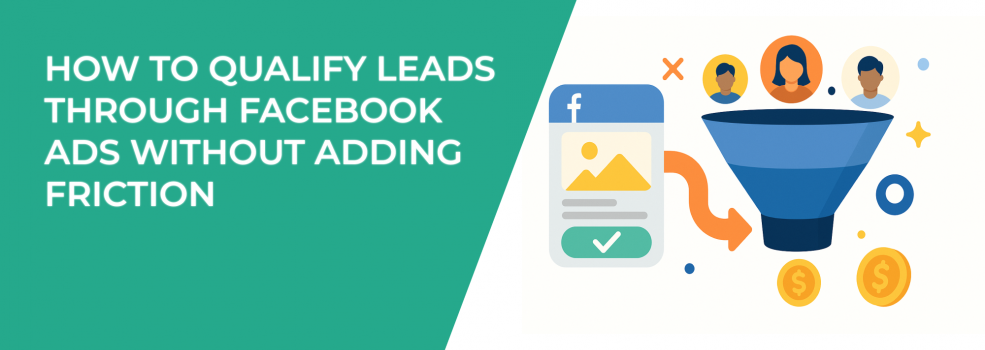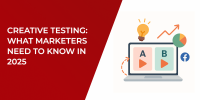Qualifying leads through Facebook Ads is no longer just about capturing contact information — it’s about understanding intent, identifying fit, and reducing wasted sales time. But here’s the challenge: the more you ask from users upfront, the fewer will convert.
So how do you strike the balance?
This guide will walk you through how to qualify leads through Facebook Ads without adding friction to the user experience. You’ll get practical strategies for form design, targeting, creative messaging, automation, and campaign optimization — all designed to attract high-intent leads without putting up unnecessary barriers.
Let’s dive in.
1. Use Meta’s Learning System to Pre-Qualify Your Audiences
Facebook (Meta) has spent years refining its ad delivery system to understand who is most likely to take meaningful action. Your job is to give the algorithm clear signals about what kind of leads you want — not just who to show your ads to, but what quality looks like.
Here’s how to structure this properly:
-
Start with strong source audiences. Build Lookalike Audiences from your best-performing customers — not just leads. This could include people who booked a call, completed a purchase, or signed a long-term contract.
-
Segment your Custom Audiences. Create remarketing audiences based on specific website behaviors, such as time on high-intent pages (e.g., pricing or service pages), not just generic site visitors.
-
Use the right conversion objective. If you optimize for top-of-funnel events like “View Content” or “Lead (Form Submitted),” you may get quantity but not quality. Instead, optimize for events further down the funnel, such as “Schedule” or “Purchase,” even when you’re running lead forms. Meta will prioritize users who resemble actual customers.
Tip: use Conversion API (CAPI) and offline event tracking to give Facebook deeper signals about who converts into paying clients. This feedback loop helps the algorithm deliver higher-quality leads over time.
2. Design Smart Lead Forms That Filter Without Creating Friction
Facebook lead forms offer speed and ease, but if you don’t customize them, they’ll bring in low-quality submissions. The trick is to make forms just frictional enough to signal intent, without overcomplicating the user experience.
Recommended strategies for lead form design:
-
Use conditional logic. Ask qualifying questions that change based on the user’s answer. For example, if someone selects “I’m exploring options,” you can follow up with softer CTAs than someone who selects “I’m ready to make a decision.”
-
Limit autofill fields. Facebook pre-populates name, email, and sometimes phone number. Leave those as-is, but add one or two custom questions that require input. This small barrier helps weed out low-intent users.
-
Prioritize multiple-choice over open-ended fields. You’ll make it easier for users to respond while still gathering useful data. Examples include:
-
Budget range
-
Timeline to purchase
-
Role or business type
-
-
Include a qualifying checkbox or disclaimer. Example: “I confirm I’m actively looking for [service] within the next 30 days.” This sets expectations and adds a layer of commitment.
-
Use context in your questions. Instead of “What are you looking for?”, say “What’s the biggest challenge you’re currently facing in scaling your [business type]?”
Best practice: test short (3-field) forms against medium (5-field) forms and monitor not just lead volume, but downstream conversion quality.
If your lead forms aren’t converting — or worse, bringing in junk leads — here’s how to optimize Facebook Lead Ads for higher conversion rates without overwhelming your audience.
3. Qualify Leads Through Ad Messaging Before the Click
Think of your Facebook ad copy and creative as your first filter. If your ad appeals to everyone, you’ll get low-quality traffic. If your ad speaks directly to your ideal buyer — and no one else — you’ll naturally reduce unqualified interest.
Tactics to use in ad creative:
-
Set expectations upfront. Include qualifiers in your headline or first line of copy. Examples:
-
“For businesses generating $100K+/month.”
-
“Only for decision-makers ready to scale fast.”
-
“Not suitable for DIY or early-stage startups.”
-
-
Speak to the decision stage. Tailor copy to the buyer’s intent level. Are they researching, comparing, or ready to buy? Avoid vague benefits and focus on outcomes relevant to buyers who are ready to act.
-
Show credibility to repel the wrong leads. Highlight results like “Booked 120 strategy calls in 3 weeks” — that appeals to serious prospects, not casual browsers.
-
Use video to add human touch and clarity. A short, to-the-point video ad explaining who you help, what you offer, and who it’s not for can go a long way in pre-qualifying.
Bonus: consider running split tests on messaging that appeals to different levels of readiness, then use dynamic creative to match different audience segments.
You can go even deeper on persuasive copywriting strategies in our article on Crafting Compelling Facebook Ads Copy That Converts.
4. Improve Post-Submission Experiences to Strengthen Lead Quality
Once a lead submits a form, most advertisers send them to a generic thank-you screen and hope for the best. But that’s a missed opportunity.
Enhance your post-submission experience to reinforce intent:
-
Redirect to a landing page with additional CTAs. Prompt qualified users to book a call, watch a demo, or complete a short quiz to further assess fit.
-
Use video thank-you pages. A personalized video can reaffirm expectations, explain next steps, and introduce your team or value proposition. This adds credibility and builds trust quickly.
-
Include segmentation options. Let users self-select their stage or priority via buttons (e.g., “Talk to Sales” vs. “Learn More”). This helps you tailor your follow-up.
-
Track behavior post-form submission. Use UTM parameters and pixel events to see which leads take further actions after submitting the form. Leads who spend time on your site or engage with content are often higher intent.
The more intentional your thank-you experience is, the easier it becomes to separate genuinely interested prospects from passive form-fillers.
5. Automate Lead Routing With Smart Segmentation
A qualified lead should never sit idle. The moment someone completes your form, they should enter a well-structured workflow that reflects their responses and behavior.
Here’s how to build a lead processing system that works:
-
Integrate with your CRM. Tools like HubSpot, Salesforce, or Pipedrive can automatically score leads based on form answers and past engagement.
-
Use branching logic in follow-up automation. If someone selected a large budget and short timeline, push them to book a call immediately. If they’re still evaluating options, enter them into a nurturing email series.
-
Flag high-value leads to sales reps instantly. Use Slack, email alerts, or mobile push notifications so your team can respond within minutes — not hours.
-
Sync with your ad account. Use offline conversion data to feed back into Facebook for better optimization. Tag qualified leads as conversions even if the sale happens outside Facebook.
Pro tip: use Zapier or other tools to create custom workflows between Facebook, your CRM, and communication tools — no developer needed.
For more automation techniques that save time and increase consistency, check out this step-by-step guide to automating Facebook Ads for small businesses.
6. Redefine What “Qualified” Means and Revisit It Often
One of the most common mistakes in lead gen is treating qualification as a fixed rule instead of a living metric. Businesses evolve. Markets shift. Campaigns mature. Your definition of a “good lead” should adapt too.
Refine your qualification criteria using actual sales data:
-
Review which ad sets, audiences, and form answers correlate with high LTV customers.
-
Talk to your sales team. What patterns do they see in successful vs. unqualified leads?
-
Monitor conversion rates through the entire funnel — not just form completions, but booked calls, no-shows, sales-qualified leads, and closed deals.
Important: avoid over-optimizing for form conversions. A campaign that delivers fewer but better leads is almost always more cost-effective in the long run.
Final Thoughts: Efficiency Beats Volume
Lead generation is no longer about filling your pipeline — it’s about filling it with the right people.
By strategically leveraging Facebook’s optimization tools, thoughtful form design, targeted messaging, and intelligent automation, you can increase lead quality without increasing friction. The result? Higher conversions, shorter sales cycles, and better ROI.

